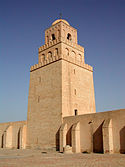| Moroccan literature |
|---|
| Moroccan writers |
| Forms |
| Criticism and awards |
| See also |
Ahmad Zarruq ( Arabic: أحمد زروق) also known as Imam az-Zarrūq ash Shadhili (Aḥmad ibn Aḥmad ibn Muḥammad ibn ‘Īsa) (1442–1493 CE) was a 15th-century Moroccan Shadhili Sufi, jurist and saint from Fes. [1] [2] He is considered one of the most prominent and accomplished legal, theoretical, and spiritual scholars in Islamic history, and is thought by some to have been the renewer of his time ( mujaddid). He was also the first to be given the honorific title "Regulator of the Scholars and Saints" (muhtasib al-‘ulama’ wa al-awliya’). [3] His shrine is located in Misrata, Libya, however unknown militants exhumed the grave and burnt half the mosque.
Life
Zarruq was born on 7 June 1442 (22nd Muharram, 846 of the Islamic 'Hijra' calendar) - according to Sheikh Abd Allah Gannun - in a village in the region of Tiliwan, a mountain area of Morocco. [4] He was of the Berber tribe of the Barnusi [5] who lived in an area between Fes and Taza, and was orphaned of both his mother and father within the first seven days of his birth. His grandmother, an accomplished jurist, raised him and was his first teacher. Zarruq is one of the most prominent scholars in the late Maliki school but is perhaps better known as a Shadhili Sufi Sheikh and founder of the Zarruqiyye branch of the Shadhili Sufi order ( Tariqa). He was a contemporary of Muhammad al-Jazuli.
He took the name 'Zarruq' (meaning 'blue') and he studied the traditional Islamic sciences such as jurisprudence, Arabic, traditions of Prophet Muhammed and wrote extensively on a number of subjects. His most famous works are first of all his Qawa’id al-Tasawwuf (The Principles of Sufism), his commentaries on Maliki jurisprudence and his commentary upon the Hikam of ibn 'Ata Allah. He travelled East to Mecca in Tihamah and to Egypt before taking up residence in Misrata, Libya where he died in 899 (1493). He was buried in Misrata, Libya.
| Part of
a series on
Islam Sufism |
|---|
 |
|
|
Quotes
- This world is like the river of Goliath from which no one who drinks is saved except the one who scoops up a handful, not the one who slakes his thirst. [6]
See also
Notes
- ^ El-Rouayheb, Khaled (8 July 2015). Islamic Intellectual History in the Seventeenth Century. Cambridge University Press. p. 248. ISBN 9781107042964.
- ^ Scott Alan Kugle, Rebel Between Spirit and Law, Indiana University Press, 2006, ISBN 0-253-34711-4, p. 7
- ^ "Zaytuna College Perennial Faculty". Archived from the original on 22 March 2015. Retrieved 11 January 2014.
- ^ Scott Alan Kugle, Rebel Between Spirit and Law, Indiana University Press, 2006, ISBN 0-253-34711-4, p. 8
- ^ "Biographie du Cheikh Zarrûq". 23 April 2012.
- ^ "Sharh Al Hikam of Ibn Atta by Ibn Ajiba". p. 21.
Bibliography
- Scott Alan Kugle, Rebel Between Spirit And Law: Ahmad Zarruq, Sainthood, And Authority in Islam, Indiana University Press, 2006, ISBN 978-0-253-34711-4
- Ali Fahmi Khashim, Zarruq, the Sufi: A guide in the way and a leader to the truth : a biographical and critical study of a mystic from North Africa
- Salah Hussein Al-Houdalieh, "Visitation and Making Vows at the Shrine of Shaykh Shihab Al-Din," Journal of Islamic Studies, 21,3 (2010), 377–390.
External links
- Zaineb S. Istrabadi, Qawa’id al-Tasawwuf, The Principles of Sufism, annotated translation with introduction, Phd thesis with extensive information on his life, times, contemporaries and interpretation of the text (pdf-file) [1] Archived 9 March 2016 at the Wayback Machine
- Foundations of the spiritual path by Sidi Ahmad Zarruq, translated by Hamza Yusuf (pdf-file) [2]
- 1442 births
- 1493 deaths
- Asharis
- Moroccan autobiographers
- Moroccan travel writers
- Shadhili order
- Moroccan Sufi writers
- Moroccan Maliki scholars
- 15th-century Moroccan writers
- People from Fez, Morocco
- 15th-century Berber people
- Berber scholars
- Berber writers
- Moroccan Islamic religious leaders
- 15th-century jurists
- Supporters of Ibn Arabi
- Sunni Sufis


